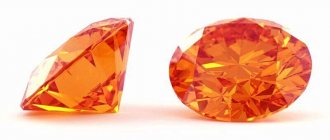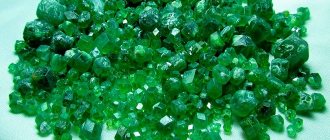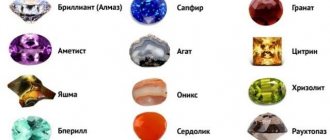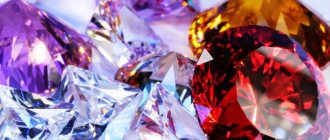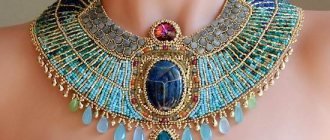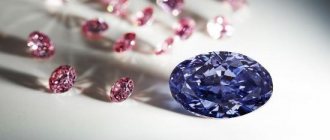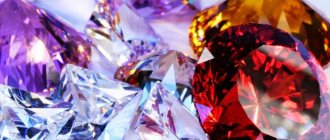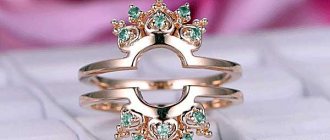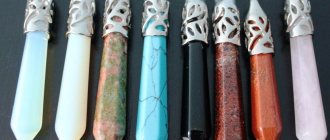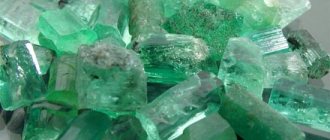Diamond
India is considered the birthplace of this stone. The stone was brought to Europe by Alexander the Great, who, having learned about the stone of incredible beauty, specially went to India to get it.
The uniqueness of a diamond lies in its structure. Thanks to its special crystal lattice, the mineral has high hardness and thermal conductivity. Contrary to popular belief, most diamonds are not colorless. Nature generously took care of the color palette of this transparent gemstone.
The most common diamond color is yellow. It is followed by brown, pink and orange. The rarest and most expensive specimens are green, blue and red. The black diamond stands apart from everyone else. Due to the large number of inclusions, it is not always possible to achieve the frequency of its cutting.
The favorite countries for diamond mining are Brazil, Russia, India, South Africa, Angola.
It is believed that a diamond has a great influence on its owner. It gives courage, confidence and protects from any negative influence.
CLEAR GEMS
Blue stones with exceptional transparency are found in nature several times less often than minerals saturated with colors. Large blue gemstones are even given their own names.
The blue Hope diamond, weighing 44.5 carats, was bought at an auction in London in 1830 by the banker of the same name. Presumably, this is a recut diamond (original weight 115 carats) stolen during the French Revolution. Now stored in Washington at the Smithsonian Institution.
The famous HOPE diamond
Diamond
- The share of blue diamonds in world production is only 0.1%.
- This rare color is created by significant boron impurities.
- In their natural form, diamonds are not distinguished by their beauty: it is the cut that creates the conditions for multiple internal reflections, due to the high dispersion of the refractive index of light (play of light).
- Before using blue stones in jewelry, jewelers cut and polish them, turning them into diamonds.
- Only after operations that emphasize the attractiveness and natural beauty, the blue mineral becomes a work of jewelry and increases in price many times over.
- The structure of the stone is a face-centered cubic space group.
- High hardness is due to the ultra-strong bond of carbon atoms.
Fancy or colored diamonds, like colorless ones, are evaluated according to several criteria:
- form;
- cleanliness;
- weight;
- blossom.
Since 1963, serial production of artificial diamonds has been established.
- Natural stone has good wettability with fat: to distinguish it from imitation, it is enough to draw a thick line across the surface.
- On a natural diamond the line will remain solid, on an artificial stone it will crumble into separate balls.
Aquamarine
Aquamarine
- The name of the gem was given for its pure blue color: it means “sea water”.
- It is a transparent variety of beryl with a strong glassy luster.
- The color of aquamarine is given by iron impurities; when exposed to UV rays, it becomes paler, and when heated to 400 degrees, it becomes brighter.
- The stone is quite fragile, so it crushes easily.
- It can be confused with tourmaline, blue topaz, euclase, and kyanite due to its similar color and transparency.
- The most valuable are blue stones with a carat value of over 10 and intense color, since the supply of raw materials is relatively large.
- The “emerald” cut is most often used, but “step” and “wedge” are also used.
Ring with 12 carat sapphire in a wood frame
Sapphire
- The blue color of sapphires is provided by impurities of iron and titanium.
- It is distinguished by high hardness and refraction of light 1.7 (for diamond 2.4), high brilliance.
- Blue minerals with a bright cornflower blue color are considered precious, while very dark and very light samples are quite cheap.
- Artificial sapphire was first synthesized in 1904 in France.
- Today, the synthetic mineral is produced on an industrial scale (hundreds of tons) in the USA, Russia, Japan, and China.
- Used in jewelry, optics, optoelectronics, LED lighting, lasers.
Gold ring with blue spinel
Spinel
Noble spinel refers to transparent crystals of various beautiful shades:
- red - at the ruby spinel (crowned with the crown of the Russian Empire);
- orange-red - in rubicella;
- pink - in ruby-bale;
- violet - from eastern amethyst;
- changing from blue to purple-violet - in spinel with an alexandrite effect;
- There is also green and blue spinel.
In jewelry, the blue-blue stone is called "spinel sapphire." We recommend: TOP 16 scarlet gems
The mineral is quite rare, second only to ruby and diamond in hardness, and has a magnificent shine and play of light.
Silver pendant with blue topaz, 165 USD
Topaz
- Naturally colored blue and cyan stones, along with golden yellow and wine yellow minerals, are considered precious, as opposed to colorless ones.
- Topazes fade in bright light, so they should be stored in the dark and preferably worn in the evening.
- When heated, the color of the mineral disappears.
- Because of the brilliance and beauty of the stone, in Russia it was called “Siberian diamond,” but its deposits were quickly mined out and abandoned.
Alexandrite
This imperial stone has the property of changing its color depending on the consecration, from pale green to dark burgundy. This transparent gemstone was first found in 1833 in the Ural mines. It was presented to the general public in April 1834 on the name day of the Russian sovereign Alexander II, which is why it got its name.
Alexandrite is a type of chrysoberyl. Its chemical composition is quite complex. It includes iron, titanium and chromium. It is thanks to the latter that this transparent gemstone is capable of a unique color reverse.
Alexandrite is rarely colorless. It is most common in bluish-green color. There are also specimens in olive and brown shades.
Today, the largest suppliers of alexandrite to the world market are Sri Lanka, India, Tanzania and Madagascar.
Alexandrite has a beneficial effect on the nervous system and psyche of its owner. There is an opinion that with its help you can recover from alcoholism.
Description of the stones
Aquamarine
| Property | Description |
| Formula | Be3Al2Si6O18 |
| Impurity | Fe |
| Hardness | 7,5—8 |
| Density | 2.67—2.71 g/cm³ |
| Refractive index | 1,577—1,583 |
| singonia | Hexagonal. |
| Kink | Conchoidal, uneven and brittle. |
| Cleavage | Absent. |
| Shine | Glass. |
| Transparency | From transparent to opaque. |
| Color | Light blue, bluish-green, greenish-blue or blue-gray. |
Like emerald, it is a type of beryl, and owes its name to its color and transparency, reminiscent of sea water. This mineral contains iron impurities and loses color when exposed to sunlight for a long time. Aquamarine is a stone of peace and wisdom, it calms nerves, stops quarrels in the family and conflicts in relationships. It protects travelers and helps them to believe in themselves.
Chrysoberyl
| Indicators | Characteristics |
| Formula | BeAl2O4 (beryllium aluminate). |
| Color | Golden-yellow, greenish-yellowish, bluish-green, emerald green, olive, brownish-green, in rare cases colorless. Sometimes there are specimens of unique gems with inclusions, stripes and dots that form a pattern. |
| Shine | It has a glass or diamond shine. |
| Transparency | It has high transparency and sometimes shines through. |
| Hardness | On the Mohs scale it is 8.5. Due to its high hardness, it is fragile and lacks features; it can be processed with diamonds. |
| Density | 3.5–3.84 g/cm³ |
| Form | According to crystallographic parameters, it is characterized by a rhomboid shape. |
| Kink | It is distinguished by a conchoidal or uneven fracture with a greasy tint. |
| Varieties | Cymophane (cat's eye) and Alexandrite. |
| Size | Reaches up to 6 cm in diameter. |
| Cleavage | In different samples, perfect, imperfect and weak are observed. |
Also Read: 12 Most Popular Green Minerals
This rare green or golden colored mineral is not always transparent, but when it is, it is considered precious. It consists of beryllium aluminate and has two varieties - alexandrite changes color from blue-green in daylight to violet in artificial light, and cymophane (cat's eye) has a characteristic light effect in the form of a moving glare on the surface. Chrysoberyl is an excellent amulet that cleanses energy and promotes an optimistic mood. This stone helps cleanse the body during intoxication, allergic reactions, alcoholism, and helps stabilize the emotional background in mental disorders.
Chrysolite
Mineral – Chrysolite
| Properties | Description |
| Formula | (Mg,Fe)2SiO4 |
| Hardness | 6,5-7 |
| Density | 3.2-4.3 g/cm³ |
| Refractive index | 1,64-1,70 |
| Cleavage | Average in one direction. |
| Shine | Glass. |
| Kink | Uneven, conchoidal. |
| Color | Green with various shades: golden, yellow, pistachio, grass, olive, brown. The coloring is very rarely intense, often in pale tones. |
A green gem with golden sparkles belongs to the olivine variety. Its shades (from golden to brown) and optical effects (“cat’s eye”, asterism) depend on admixtures of magnesium and iron, and transparency is associated with admixtures of mica, chromite, and serpentine. In lithotherapy, chrysolite is used as a remedy for the treatment of nervous disorders and anxiety, hormonal disorders, as well as for recovery from injuries and serious illnesses. The mineral is recommended as a talisman against dangerous situations and a talisman that attracts good luck.
Hyacinth
| Options | Properties |
| Stone(Hyacinth) | Silicate. |
| Formula | Zr[SiO4] |
| Hardness | 7–7,5 |
| singonia | Tetragonal. |
| Density | 3.9—4.8 g/cm³ |
| Kink | Very fragile, conchoidal. |
| Cleavage | Imperfect. |
| Transparency | Transparent. |
| Shine | Glass (strong) or diamond. |
| Stroke color | White. |
| Colors | Yellow, red-brown, yellow-red. |
| Refraction | 1,777—1,987 |
The red colored gemstone is a subtype of zircon. Manganese gives the mineral its characteristic shade; in the presence of other impurities, the color of hyacinth can vary from brown-red to yellow. It is considered an assistant in preserving youth and beauty - it improves metabolism, heals wounds, including mental ones, and relieves stress. Wearing hyacinth helps improve self-esteem and improve performance.
Emerald
| Property | Description |
| Formula | Be3Al2Si6O18 |
| Impurity | Fe2O3, V2O3, Cr2O3 |
| Hardness | 7.5-8.0 on the Mohs scale. |
| Density | 2.69—2.78 g/cm³ |
| Refractive index | nω = 1.564—1.595, nε = 1.568—1.602 |
| singonia | Hexagonal. |
| Kink | Conchoidal and uneven. |
| Cleavage | Imperfect. |
| Shine | Glass. |
| Transparency | Transparent or translucent. |
| Color | Green, yellowish-green. |
Iron, chromium and vanadium give the stone its rich green color. Sometimes you come across emeralds interspersed with gas bubbles and other minerals, and the presence of a network of cracks and nets is a sign of its naturalness. Lithotherapists recommend using the stone as a means to treat the stomach, genitourinary and hormonal systems . Emerald helps eliminate negativity and evil that manifest themselves both in the owner’s soul and when externally influenced. It is considered a “female” stone, as it best reveals its magic in female hands.
Diamond
| Property | Description |
| Formula | WITH |
| Impurity | N |
| Hardness | 10 |
| Molecular mass | 12,01 |
| Density | 3.47—3.55 g/cm³ |
| Refractive index | 2,417—2,419 |
| Fragility | Lasting. |
| Cleavage | Perfect on {111}. |
| Kink | Conchoidal to the point of splintering. |
| singonia | Cubic. |
| Optical axis dispersion | Strong. |
| Twinning | Twin germination according to the spinel law is common. |
| Shine | Diamond. |
| Transparency | Transparent. |
| Color | Colorless, yellow, brown, blue, light blue, green, red, pink, black. |
This mineral is known for its hardness, but its quality and cost depend on the color and transparency of the processed stone - diamond. Its shades range from yellow to black, but a colorless, completely transparent crystal is considered classic. Diamond helps to achieve peace of mind and helps with age-related mental disorders, protects against infections and poisoning, and has a positive effect on the condition of the lungs. The strong energy of the stone is aimed at increasing the success and determination of the owner. Diamond promotes attractiveness in the eyes of the opposite sex, awakens passion, and gives energy.
Also read: Grossular - a good-natured relative of the pomegranate
Andalusite
| Property | Description |
| Formula | Al2SiO5 |
| Hardness | 7,5 |
| Density | 3.12—3.18 g/cm³ |
| Refractive index | 1,641—1,648 |
| Kink | Uneven, fragile |
| singonia | Rhombic |
| Cleavage | Imperfect |
| Shine | Glass |
| Transparency | Transparent |
| Color | Grey, yellow, brown, golden, orange-brown, pink, red, dark green or colorless |
A yellow or brown transparent stone can change color depending on the lighting and has a pronounced shine. The healing properties of andalusite include its positive effect on the heart and blood vessels, respiratory and musculoskeletal systems. Lithotherapists recommend it to speed up metabolism and reduce appetite in obesity, as well as to improve mood during a diet. Esotericists believe that the stone has pronounced magical powers and is a guide to the other world.
Taaffeit
| Property | Description |
| Formula | Mg3Al8BeO16 |
| Shine | Glass. |
| Transparency | Transparent. |
| Hardness | 8–8,5 |
| Cleavage | Imperfect. |
| Kink | Conchoidal. |
| Density | 3.6 g/cm³ |
| singonia | Hexagonal. |
| Refractive index | nω =1.722, nε=1.777 |
The rarest purple transparent mineral is a “relative” of chrysoberyl and contains aluminum, magnesium, and beryllium. Taaffeite was discovered relatively recently - in 1945, and there are several dozen specimens in the world, so the mineral is inaccessible to most lithotherapists and esotericists. It is believed that the stone affects the psycho-emotional sphere and immunity, increases performance, and removes psychological restrictions.
Corundum (sapphire and ruby)
| Options | Properties |
| Formula | AI2O2 |
| singonia | Trigonal. |
| Shine | Glass, matte. |
| Melting temperature | 2050°C |
| Density | 3.9–4.1 g/cm³ |
| Kink | Uneven. |
| Hardness | 9 |
| Transparency | Opaque, sometimes transparent. |
| Color | Blue, pink, brown, red, yellow, gray. |
It is an aluminum oxide, the richness of its shades is caused by the inclusion of chromium oxide (red), titanium (blue), iron (yellow). The most expensive is considered colorless, completely transparent corundum. The stone relieves bad mood and alleviates joint diseases, and also has a positive effect on the heart (ruby), eyes (sapphire), and gastrointestinal tract (yellow corundum). Rubies are considered the stones of leaders, and sapphires are considered to be a talisman for lovers. Corundums are stimulants of vitality and intellectual abilities; wearing them is recommended when performing responsible work.
Rhinestone
| Property | Description |
| Formula | SiO2 |
| Hardness | 7 |
| Density | 2.6 g/cm³ |
| singonia | Trigonal. |
| Cleavage | Unclear by rhombohedron. |
| Kink | Uneven, sometimes conchoidal. |
| Shine | Glass. |
| Transparency | Transparent. |
| Color | Colorless, the color depends on various impurities and other stones are formed, such as: rauchtopaz, amethyst, etc. |
The stone is crystalline quartz, most often colorless, but sometimes taking on a purple or yellow tint. In lithotherapy, it is used as a universal restorative due to its pronounced positive energy. Rock crystal brings spiritual harmony to the owner, helps to understand difficult situations, and relieves negative energy.
Pomegranate
| Property | Description |
| Formula | R2+3 R3+2 [SiO4]3 |
| Hardness | 6,5—7,5 |
| Density | 3.47 - 3.83 g/cm³ |
| singonia | Cubic. |
| Kink | Uneven. |
| Cleavage | Absent. |
| Shine | Glass. |
| Transparency | Transparent or translucent. |
| Color | Red, bright red, orange, lilac, green, violet, black, chameleons (in the light of the sun - bluish-green, under the light of an electric lamp - lilac-green). |
Also read: 13 Most Popular White Minerals
It is a semi-precious stone and breaks down into a whole group of silicate minerals - red pyrope and almandine, purple rhodolite, green andradite and grossular, orange spessartine. Pomegranate promotes tissue regeneration and restoration of the body after stress and illness, stimulates cardiac activity, helps pregnant women safely bear and give birth to a child. The stone helps true friends and loving people, awakens passion and instills the will to live.
Morganite (sparrow)
| Property | Description |
| Formula | Be3Al2(Si6O18) |
| Density | 2.6-2.9 g/cm³ |
| Transparency | The stone may be completely translucent or slightly cloudy. |
| Hardness | On the Mohs scale, morganite reaches 7.5–8. |
| Refractive period | 1, 56–1,6. |
| Kink | Conchoidal and uneven. |
Like aquamarine, it belongs to the beryl group, and the cesium, lithium and manganese in its composition give the mineral a pinkish color. Brightly colored stones have a high content of radioactive cesium, so they are worn only on the hands and feet. Morganite helps people susceptible to emotional exhaustion and mental illness, and its beneficial effect on brain function contributes to educational and scientific activities. Recommended for people seeking self-improvement, and also has a positive effect on family relationships.
Amethyst
| Property | Description |
| Formula | SiO2 (silica) |
| Impurities | Fe²+, Fe³+ |
| Hardness | 7 |
| Density | 2.63 - 2.65 g/cm³ |
| Refractive index | 1,543 — 1,554 |
| singonia | Trigonal. |
| Kink | Conchoidal, rather fragile. |
| Cleavage | Absent. |
| Shine | Glass, mother-of-pearl. |
| Transparency | Transparent. |
| Color | Violet to pale reddish-violet, black, pink. |
It is a type of quartz and contains iron, the content of which determines the shade. Under the influence of high temperatures, the stone loses color and becomes colorless, then yellow and turns into citrine. In lithotherapy it is used as a means of cleansing the blood and stimulating its renewal. It has a positive effect on the functioning of the right hemisphere of the brain and helps increase intelligence. The magic of amethyst allows you to take control of negative emotions and achieve peace.
Aquamarine
A transparent, blue-colored gemstone that is a variety of beryl. The most valuable minerals are those that have the color of clean and transparent sea water.
The peak of aquamarine's popularity came at the beginning of the twentieth century and the Art Deco style. Its icy transparency has made aquamarine one of the favorite materials of jewelers, along with diamonds, emeralds and sapphires. It looked great in the rectangular cut that was popular at that time, which only emphasized its laconic severity.
The most significant deposits of the gem are located in Brazil, Russia and Madagascar.
The stone is able to protect its owner from lies and negative influences. He knows how to support the feelings of lovers and resolve disputes.
Blue and turquoise
A transparent stone of turquoise and blue color will become an amulet and talisman for a person whose thoughts and intentions are pure, like a cloudless sky or the surface of the sea. Combinations of blue stones with transparent and opaque properties in one product allow you to create unusually beautiful jewelry.
Turquoise nuggets in gold rings and rings protect the owner from envy and evil thoughts. Godparents and parents give amulets in turquoise with a transparent stone to children. It is believed that such a gift will provide the little man with a cloudless future.
Sapphires, topazes, and spinel are the most popular blue transparent stones. They are used by lithotherapists in the treatment of:
• eye diseases; • mental illness; • pathologies of the gastrointestinal tract and respiratory organs.
A blue transparent stone in gold earrings will add a little mystery to the hostess's image. A necklace or bracelet made of crystal emerald stones will give elegance and sophistication.
Hyacinth
This stone of wisdom and good luck is shrouded in mystery and magic. The mineral is a transparent jewelry variety of zirconium with a diamond luster. It contains manganese, which is why it has a red-brown color palette.
Hyacinth is a rare and prized stone by jewelers. Due to its high hardness, it can be processed with step or brilliant cuts. The density and refractive index of this mineral depends on the deposit.
It is mined in Vietnam, India, Sri Lanka, Madagascar and Russia.
According to ancient symbolism, hyacinth is a stone of success and constancy. It can improve vision, preserve youth and protect against nightmares. He gives prosperity, helps to get rich and recognize lies.
Transparency of the mineral
Transparency
- the ability of a mineral to transmit light through itself. It is assessed at a qualitative level by viewing the mineral against light. Depending on the degree of transparency, all minerals observed in large crystals are divided into the following groups:
- transparent: colorless crystals of rock crystal (optical quartz), calcite (Iceland spar), fluorite (optical fluorite), topaz, apophyllite, halite, gypsum (“Maryino glass”), muscovite. Transparent colored minerals make up the majority of precious and jewelry stones that are cut (jewelry varieties of beryl, corundum, tourmaline, spinel, etc.);
- translucent: densely colored minerals with high refractive indices - low-iron sphalerite or cinnabar, realgar or orpiment, many garnets, light-colored cassiterite, manganotantalite, etc., as well as amorphous minerals - opal, amber;
- opaque: most ore minerals - sulfides and their analogues (with the exception of some blendes, like sphalerite or cinnabar), pyrites (pyrite, arsenopyrite, chalcopyrite, etc.), lusters (galena, molybdenite, etc.), fahlores and related these include sulfosalts, as well as many iron oxides (magnetite, ilmenite, etc.), native metals and some non-metals (graphite); Most minerals are opaque and their crystal structure is dominated by a metallic bond.
Along with translucent minerals, translucent minerals are often classified into a special group. For example, translucent in thin leaves, biotite; edges of grains or fragments, rutile. Hematite, translucent red in thin fragments; chromite, translucent brown; gold in the thinnest leaves translucent green. Occasionally, minerals are found that are transparent in one crystallographic direction and translucent or translucent in all others. An example of such a mineral is sodium borate and ulexite, which form parallel-fiber aggregates. It is transparent along the fibers and less transparent in the transverse direction, that is, it behaves like a kind of natural light guide, for which it was given the name “TVstone” in the USA.
The assignment of a mineral to one group or another largely depends on the thickness of the mineral individual, but in general, in practical work these characteristics are useful. The degree of transparency is also influenced by the nature of the crystal surface and the aggregate structure of the mineral substance. Mineral bodies, composed not of one individual but of many grains, often appear opaque due to internal scattering and reflection of light. Colorless minerals can acquire a milky white color. The same phenomenon occurs if a single crystal that is transparent in itself contains numerous inclusions made of gas or liquid (milky quartz), and translucent crystals are almost opaque for the same reasons.
Rhinestone
This mysterious white and transparent gem has been surrounded by an aura of mysteries and legends since ancient times. Ancient philosophers believed that rock crystal was water frozen and turned into ice by the power of magic.
If we turn to science, this mineral is a type of quartz. Pure crystals without any defects are rare and highly valued. Specimens of 3 cm and more are of practical importance.
In ancient times, various vessels and decorations were carved from it. And now, when you go to a jewelry store, you can see earrings, rings, pendants and bracelets with rock crystal on the counter.
Many people associate products made from this stone with witchcraft. Suffice it to recall the indispensable attribute of all fortune tellers - the crystal magic ball. The main property of the mineral is the ability to grant a person clairvoyance.
But the disinfectant properties of rock crystal have been scientifically confirmed. It is applied to wounds and bruises for quick healing. The mineral, placed under the pillow, can relieve insomnia.
Emerald
Natural emerald is a transparent green gemstone and belongs to the beryl group. According to the classification, emerald, together with diamond, alexandrite, sapphire and ruby, belongs to the first-order semiprecious minerals.
An important criterion is its transparency and color. A perfect emerald is a crystal clear and transparent stone with an even color distribution. Specimens over 5 carats are valued higher than diamonds.
Emeralds from Colombia are considered especially expensive. They have a lush grassy green hue. But Zambian emeralds are distinguished by their special transparency and purity of shine. They are much darker than Colombian and can even have blue tones. High-quality emeralds are also mined in Brazil, Russia, Afghanistan and Egypt.
If we talk about the magical properties of this transparent gem, then its task is to rid its owner of bad habits - infidelity, deceit, fraud. If its owner does not have bad inclinations, then the emerald will grant him health and good luck.
Ruby
Ruby is a variety of corundum and belongs to the oxide class of minerals. A transparent gemstone second only to diamond in hardness. It is found on all continents of the earth except Antarctica. The most significant ruby exporting countries are Myanmar, Sri Lanka and Thailand.
Ruby has a special fiery red color that other transparent gems do not have (photo). This occurs due to the presence of chromium impurities in the mineral.
This stone was mined in Burma during the Bronze Age. Rubies were also highly valued in Ancient India. There they were used to make talismans.
This stone is considered a symbol of passion, energy and power. It gives a person strength and protects against black magic. There is also an opinion that by changing its color, a ruby warns its owner from danger.
TRANSPARENT SEMI-PRECIOUS STONES
“Semi-precious” stones, including blue ones, mean minerals that are very popular among jewelers, but are not considered expensive precious stones (diamond, sapphire, emerald, ruby, alexandrite, natural pearls).
Transparent semi-precious minerals are distinguished by their high hardness and, as a result, ease of cutting. That's why jewelers like to work with them. Buyers love such gems because of their wide color palette and shine at a relatively low cost.
Wedding ring with natural blue zircon
Zircon
- The mineral is the oldest material discovered on the planet.
- In the 2000s, crystalline zircon was found in Australia, whose age exceeds 4 billion years.
- The stone has a “diamond” luster, hardness 7-8 on the Mohs scale, and density 4.2 g/cu. cm.
- Zircon always contains radioactive (uranium, thorium) and rare earth elements, so it is usually radioactive.
The natural color of a mineral can be:
- brownish yellow;
- brown;
- gray;
- red;
- pink.
May be colorless.
To obtain the bright blue color, zirconium is calcined to create a mineral called “starlite.” Cabochons, larimar
Larimar
One of the light blue stones is larimar, a type of pectolite with a cloudy tint.
The color of the mineral can be:
- light blue;
- greenish-blue;
- white;
- dark blue.
Blue stone is mined in only 2 places on Earth - in the Dominican Republic and in Italy. Larimar owes its naturally rare color to the inclusion of vanadium in small quantities.
Recommended: Review of 15 BLUE STONES
The mineral received its name in honor of one of the daughters of the discoverer of Larisa and the sea in Spanish (mar), since the main shade is the color of the sea wave.
Types of tourmaline
Tourmaline
The blue natural stone of the tourmaline group is called “olenit”, and the intense blue one is “indigolite”, which is relatively rare. Tourmaline in blue and blue shades is used as an inexpensive semi-precious stone in jewelry. Due to the thickness of the color, a flat cut in the form of a square or rectangle is predominantly used.
Celtic necklace with blue chalcedony, 70 USD
Chalcedony
- Blue translucent chalcedony is a stone that is a type of quartz and has a jewelry trade name “sapphirine”.
- The reason for the blue tint of chalcedony has not yet been fully elucidated, but it is assumed that it is due to the insignificant zircon content.
- When heated, the shades of sapphirine fade.
Sapphire
A blue, transparent gemstone from the corundum variety. Its shades can vary from pinkish to black, but mineralogists consider dark blue sapphires to be true. Its characteristic is a high degree of hardness and a strong glass luster.
The most valuable sapphire deposits are located in Asia, India and the USA. The most famous sapphires are Kashmir sapphires. They got their name from the place of their production - Kashmir (a region in the north of Hindustan).
Sapphire is considered a heavenly stone and has cosmic energy. It is often used during meditation. It pacifies passions, strengthens the spirit, and brings loyalty and love to the family.
Topaz
The precious transparent stone received its name from the place where it was first discovered on the island of Topazios in the Red Sea. Its color range is very diverse: from brown to blue, yellow and pink. Colorless minerals are also often found.
As history indicates, it was this stone that in ancient times adorned the crowns of kings and sultans of many countries. In Russia in the 19th century it was called the “Siberian diamond”. Currently, the world's topaz suppliers are Germany, Zimbabwe, Madagascar and Brazil.
Untreated topaz has virtually no shine. Only after cutting does it develop an amazing glass shine, which allows you to admire the extraordinary radiance of the gem in jewelry.
It is believed that topaz protects against damage and witchcraft and gives the body the strength to cope with depression. You can call upon him for help when you need to concentrate or calm down.
What clear stones are used to create jewelry?
Not all transparent stones are suitable for jewelry. Some are too fragile or not shiny enough. Danburite, aragonite, barite, phenacite - all these minerals are extremely beautiful, but due to their rarity they are used mainly as collection material. Jewelry is often inlaid with the following precious rocks:
- diamonds;
- beryls;
- spinel;
- sapphires;
- quartz;
- tourmalines;
- topaz;
- zircons.
Rhinestone
Clear quartz is popularly known as rock crystal. This is an inexpensive but beautiful stone with powerful energy. Magicians and psychics often use it for rituals. Actually, the concept of “magic crystal” traditionally means rock crystal.
Colorless diamonds
Colorless diamonds are rare in nature because they require an almost complete absence of impurities to appear. And most samples contain nitrogen, which adds yellowness. Such stones are cheaper and are considered less beautiful. One of the key features of the rock is the highest refractive index among all minerals. For diamonds it reaches almost 2.5. And for other stones the coefficient rarely reaches at least two units. This explains the inimitable brilliance of diamond gems.
cubic zirconia
The only stone that can compete with diamond in brightness is cubic zirconia. This is an artificial gem that is synthesized in the laboratory. It does not occur in nature
Cubic zirconia has much in common with diamond: the refractive index is higher than two, the hardness is not far from the standard - 8.5 on the Mohs scale. Diamonds and cubic zirconia are difficult to distinguish with the naked eye; they are very similar. The difference is usually determined under a microscope or using light tests. Despite all the similarities, laboratory stone is hundreds of times cheaper than natural jewelry.
Zircon
Zircon is considered a natural counterpart of diamond . Transparent specimens of this breed have their own names: hyacinth and slang. These stones are also capable of producing a bright play of colors with reflections when rays are reflected, but they are also characterized by a high birefringence index. Diamonds do not have this effect at all. Colorless zircon is obtained in two ways:
- extracted in this form from the deposit;
- brown zircons can be heat-treated, the shade of which is burned out due to exposure to high temperature.
Leucosapphire
Another precious mineral that cannot be ignored is leucosapphire. This is a subspecies of sapphire, a representative of the corundum group. Leucosapphires are rarely completely colorless. They usually contain subtle shades of blue, yellow, white or purple.
Demantoid
This transparent green gemstone is considered the most expensive variety of garnet. It has been known since ancient times and before, by mistake, it was often called chrysolite. It was this gem that was a favorite in the jewelry collections of the noble class at the end of the 19th century.
Due to the fact that demantoids are quite rare, they represent considerable jewelry value. The color play of this mineral is even stronger than that of diamond.
This gem helps its owner become more collected and concentrated. Beads made from this stone improve the functioning of the heart, and the bracelet eliminates infertility.
Noble spinel
This beautiful semi-precious stone comes in a variety of shades. Its individual copies are comparable to the cost of rubies and sapphires. Noble spinel contains various mineral impurities that color it in all sorts of shades: blue, yellow, green, brown, red and even black.
The richest deposits of spinel are in Myanmar, Sri Lanka, Tajikistan, Brazil and India.
The stone is perfect for people whose work involves business trips. He is able to create favorable conditions for the life of his owner, attracting finances and good luck.
Chrysoberyl
The name of the gem comes from the Greek χρυσος, which translates as “gold”. The mineral has a glassy luster and comes in golden, blue, green, gray or brown shades.
The highest quality crystal samples are collector's items, and the value of some specimens may exceed their value in jewelry.
Chrysoberyl deposits are found in Brazil, Ceylon, Madagascar and the USA.
Wearing a gold ring with chrysoberyl promotes the development of intuition and insight. It is believed that this gem can relieve hangovers.

